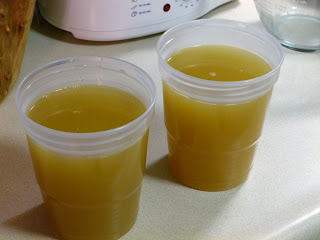Now, as we've well documented, this hasn't been a particularly stellar year in our garden, what with the moving process, the small space allotment we had, and the combination of theft by others and neglect by us. But just because we had a small harvest doesn't mean that everyone else in central Iowa did. One of the many successful growers in our area this year was Iowa Orchard, a neat little fruit oasis in the middle of the Des Moines suburbs.
We're a little ways beyond apple season here in Iowa by now, but we did our best to take advantage of it while it was going on (from July to October, per Iowa Orchard's website). We picked up several pecks of apples over the fall, many for fresh eating, but one peck of Cortlands was specifically earmarked for apple butter.
If you've never had apple butter, first of all, give it a try; it's delicious! But secondly, it's a fruit butter, which is a lot like a jam, but spreads much easier. You can make and preserve it at home with a few simple tools, as long as you follow the right procedure. That is of the utmost importance, since improper canning can make you quite sick or even be fatal. You can follow our process here as a general concept, but make sure you have a trusted manual to ensure you follow the right safety procedures. A good bet is the Ball Blue Book, which we used for our recipe here. Just be careful, and home canning can be perfectly safe.
With that disclaimer stated, the first step in making apple butter is basically to make homemade applesauce, or a nice apple puree. Our recipe called for four pounds of apples to make a half dozen jars of apple butter. We weighed our peck to be about 10 pounds, and it ended up making 14 jars (two separate batches), which is about the same proportion. These needed to be peeled and cut into pieces, which you can do by hand... Unless you have an Apple Master!
It peels!
It slices!
It dices... er, cores!
Our Apple Master was a find at the local TJ Maxx, which made it a reasonable bargain, especially considering that we planned to continue making apple butter in our futures. It helps, but it's not necessary; you can just peel with a knife and then cut into pieces. The apples went into a big pot with 2 cups of water per 4 pounds of apples, where they simmered on the stovetop until soft, somewhere between 10 and 15 minutes maybe. You'll be able to tell when the apples soften, so you likely won't need to time it.
Next we put the softened apples into our second gadget of the process: a food mill. This step could be done in a regular food processor, but it doesn't work quite as well. If you plan to make apple butter semi-regularly, we'd recommend you invest in the food mill. It basically presses the apple slices through a grate in the bottom, which also serves to strain out any skins or tough parts that didn't get Apple Mastered away. A food processor wouldn't have that filtering ability, plus there's the danger that it's too powerful - liquefying the apples instead of making a puree. And it's just so much fun, in an old-fashioned kind of way, to crank away at the apples and watch the mush drip through the bottom.
If you want to make your own applesauce, congratulations, that's pretty much what you've got here! It hasn't been seasoned in any way, and it's still a little too squishy to spread onto toast, so it needs a little more work to become what we want. Come back next time and we'll show you the rest of the journey, where it transforms from puree into the thick, amber goodness of apple butter. We'll also break out the canner, and (very carefully) pack it into shelf-stable jars we can enjoy for months to come. See you then!
















































